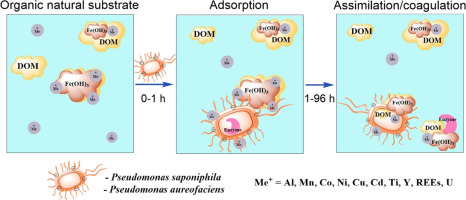Science of the Total Environment ( IF 8.2 ) Pub Date : 2017-11-09 , DOI: 10.1016/j.scitotenv.2017.10.340 Olga V. Oleinikova , Liudmila S. Shirokova , Olga Y. Drozdova , Sergey A. Lapitskiy , Oleg S. Pokrovsky

|
The heterotrophic mineralization of dissolved organic matter (DOM) controls the CO2 flux from the inland waters to the atmosphere, especially in the boreal waters, although the mechanisms of this process and the fate of trace metals associated with DOM remain poorly understood. We studied the interaction of culturable aquatic (Pseudomonas saponiphila) and soil (Pseudomonas aureofaciens) Gammaproteobacteria with seven different organic substrates collected in subarctic settings. These included peat leachate, pine crown throughfall, fen, humic lake, stream, river, and oligotrophic lake with variable dissolved organic carbon (DOC) concentrations (from 4 to 60 mg L− 1). The highest removal of DOC over 4 days of reaction was observed in the presence of P. aureofaciens (33 ± 5%, 43 ± 3% and 53 ± 7% of the initial amount in fen water, humic lake and stream, respectively). P. saponiphila degraded only 5% of DOC in fen water but did not affect all other substrates. Trace elements (TE) were essentially controlled by short-term (0 − 1 h) adsorption on the surface of cells. Regardless of the nature of organic substrate and the identity of bacteria, the degree of adsorption ranged from 20 to 60% for iron (Fe3 +), 15 to 55% for aluminum (Al), 10 to 60% for manganese (Mn), 10 to 70% for nickel (Ni), 20 to 70% for copper (Cu), 10 to 60% for yttrium (Y), 30 to 80% for rare earth elements (REE), and 15 to 50% for uranium (UVI). Rapid adsorption of organic and organo-mineral colloids on bacterial cell surfaces is novel and potentially important process, which deserves special investigation. The long-term removal of dissolved Fe and Al was generally consistent with solution supersaturation degree with respect to Fe and Al hydroxides, calculated by visual Minteq model. Overall, the biomass-normalized biodegradability of various allochthonous substrates by culturable bacteria is much lower than that of boreal DOM by natural microbial consortia.
中文翻译:

亚北极水中溶解性有机物和微量金属的生物降解性低
溶解有机物(DOM)的异养矿化控制了从内陆水域到大气中的CO 2通量,特别是在北方水域,尽管这一过程的机理以及与DOM相关的微量金属的命运仍知之甚少。我们研究了可培养的水生(Pseudomonas saponiphila)和土壤(Pseudomonas aureofaciens)丙型变形杆菌与在弧下环境中收集的七种不同有机底物之间的相互作用。这些包括泥炭渗滤液,松树冠穿透,芬,腐殖质湖,溪流,河流和贫营养湖,其溶解有机碳(DOC)浓度各不相同(4至60 mg L − 1)。在金黄色葡萄球菌的存在下,观察到在4天的反应中DOC的去除率最高(分别在水,腐殖质湖和溪流中分别为初始量的33±5%,43±3%和53±7%)。在水中,Saponiphila只能降解5%的DOC,但不会影响所有其他底物。微量元素(TE)基本上是通过短期(0-1小时)在细胞表面的吸附来控制的。不论有机底物的性质和细菌的种类如何,铁(Fe 3 +)的吸附度范围为20%至60 %,铝(Al)的吸附度为15至55%,锰(Mn)的吸附度为10至60% ,镍(Ni)的10%至70%,铜(Cu)的20%至70%,钇(Y)的10%至60%,稀土元素(REE)的30%至80%,铀的15%至50% (UVI)。有机和有机矿物胶体在细菌细胞表面上的快速吸附是新颖且潜在的重要过程,值得进行特殊研究。长期去除溶解的铁和铝通常与通过视觉Minteq模型计算得出的关于铁和铝氢氧化物的溶液过饱和度一致。总体而言,可培养细菌对各种异源底物的生物量归一化生物降解能力远低于自然微生物聚生体对北方DOM的降解能力。











































 京公网安备 11010802027423号
京公网安备 11010802027423号